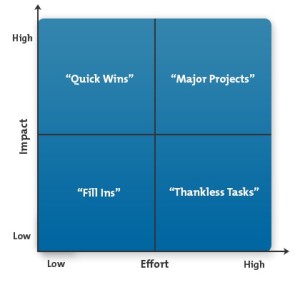"The Action Priority Matrix"
(Making the Most of Your Opportunities)
Click here to download the Worksheet Whether these are bright ideas to pursue, exciting opportunities, or interesting possibilities, most of us have many more activities on our "wish lists" than we have time available to work on them. By choosing activities intelligently, we can make the very most of our time and opportunities. However, by choosing badly, we can bog ourselves down in time-depleting, low-yield projects that stop us moving forwards. This is where an "Action Priority Matrix" can be useful. These simple diagrams help you choose the activities you should prioritize and the ones you should avoid, if you want to make the most of your time and opportunities.About the Tool
Action Priority Matrices (see the above figure-1) show you how to prioritize activities to make the most of your time, energy, and talents. This is useful, because we rarely have time to complete all of the tasks and projects on our wish lists. When we use the matrix to choose activities intelligently, we can spend more of our time on the high-value activities that keep us moving forwards. We can also drop tasks that contribute little. Make most of the opportunities
Make most of the opportunities Figure 1 – The Action Priority Matrix
To use the matrix, you score tasks based firstly on their impact and secondly on the effort needed to complete them. You then use your scores to plot these activities in one of four quadrants:Quick Wins (High Impact, Low Effort)
Quick wins are the most attractive projects, because they give you a good return for relatively little effort. Focus on these as much as you can.Major Projects (High Impact, High Effort)
Major projects give good returns, but they are time-consuming. This means that one major project can "crowd out" many quick wins.Fill Ins (Low Impact, Low Effort)
Don't worry too much about doing these activities – if you have spare time, do them, but drop them or delegate them if something better comes along.Thankless Tasks (Low Impact, High Effort)
Try to avoid these activities. Not only do they give little return, they also soak up time that you should be using on quick wins. Tip: Once you understand the principles behind the Action Priority Matrix, you'll probably find that you apply it quickly and intuitively to new tasks and projects.How to use the Tool
To use the Action Priority Matrix, use the above given worksheet and then follow these steps:Step 1
List the major activities that you want to or need to complete.Step 2: Click here to read the remaining steps
Variants of the Tool
The approach we describe above explains how you can use the Action Priority Matrix as an informal or personal way of prioritizing tasks. However, you can use this approach on a larger scale by using, for example, "financial return" as the scale on the vertical axis, and "person months" on the horizontal axis. Alternatively, you could substitute "feasibility" for "effort" on the horizontal axis to prioritize projects based on your ability to implement them. (This variant is sometimes known as the "Impact/Feasibility Matrix.")Key Points
The Action Priority Matrix is a simple tool that helps you chooses which activities to prioritize, and which activities to delegate or eliminate. This helps you make best use of the opportunities available to you.
The matrix has four quadrants:
- Quick wins.
- Major projects.
- Fill ins.
- Thankless tasks.
To use the matrix, make a list of your ongoing activities and goals. Score each task on impact and effort, using a 0 to 10 scale. Next, plot your activities on the matrix, and then prioritize, delegate, or drop activities appropriately.
Click Here to read the full article and Download the WorksheetClick Here for Related Topics: http://qtm.co.in/help_advice.php